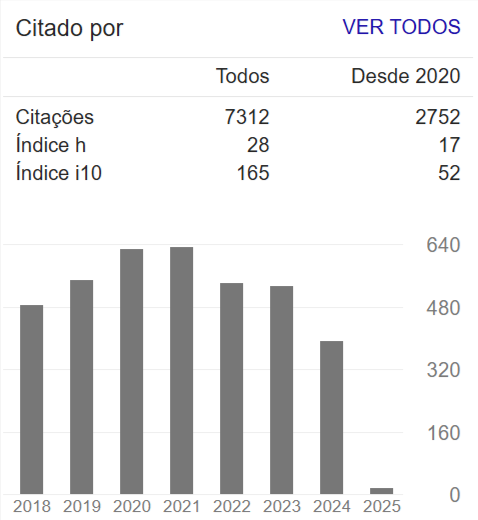Spatial distribution of stable isotopes (18O and 2H): links between precipitation, surface and groundwater and geomorphological impact in a poorly drained plain, Cordoba, Argentina
Abstract
The aim of this study is to establish the relationships between the spatial distribution of the isotopic composition of surface and groundwater with geomorphological factors and precipitation, using isotopic techniques, in the urban and rural area of Canals, located in a sector of the Pampean Plain, in the province of Córdoba, Argentina. Drainage in the region is moderately impeded, with the presence of dunes and deflation basins with lagoons. The free aquifer present is composed of fine and very fine sands. The hydraulic interconnections were evaluated by conventional hydrogeological methodology and stable water isotope analysis (δ²H and δ¹⁸O). Hydrodynamics and geochemistry indicate that the aquifer has flows of different hierarchies, both local and intermediate from upstream. The hydraulic, geochemical and isotopic relationships are influenced by morpholithological factors, the depth of the water table and anthropogenic activity (on-site sanitation systems, intensive agriculture and livestock farming, among others).
References
AHMED, M.; KHALIL, M. M. Isotopic and chemical composition of Egypt’s groundwater resources. In: GROUNDWATER quality and geochemistry in arid and semi-arid regions. Cham: Springer Nature Switzerland, 2023. p. 237-265. https://doi.org/10.1007/698_2023_1046 DOI: https://doi.org/10.1007/698_2023_1046
AKTER, F.; BISHOP, T.; VERVOORT, R. Space-time modelling of groundwater level and salinity. The Science of the Total Environment, v. 776, 145865, 2021. https://doi.org/10.1016/j.scitotenv.2021.145865 DOI: https://doi.org/10.1016/j.scitotenv.2021.145865
AMERICAN PUBLIC HEALTH ASSOCIATION (APHA). Standard methods for examination of water and wastewater. 23 ed. Washington: APHA, AWWA, WPCF, 2017.
AZPURUA, M. A.; RAMOS, K. D. A comparison of spatial interpolation methods for estimation of average electromagnetic field magnitude. Progress in Electromagnetics Research M, v. 14, p. 135–145, 2010. https://doi.org/10.2528/pierm10083103 DOI: https://doi.org/10.2528/PIERM10083103
BALWAN, W. K.; KOUR, S. Wetland-an ecological boon for the environment. East African Scholars Journal of Agriculture and Life Sciences, v. 4, n. 3, p. 38-48, 2021. https://doi.org/10.36349/easjals.2021.v04i03.001 DOI: https://doi.org/10.36349/easjals.2021.v04i03.001
BARBIERI, M. Isotopes in hydrology and hydrogeology. Water, v. 11, n. 2, p. 291, 2019. DOI: https://doi.org/10.3390/w11020291
BIRKEL, C. et al. Characterization of surface water isotope spatial patterns of Scotland. Journal of Geochemical Exploration, v. 194, p. 71-80, 2018. DOI: https://doi.org/10.1016/j.gexplo.2018.07.011
BLARASIN, M. et al. Application of isotope techniques to enhance the conceptual hydrogeological model and to assess groundwater sustainability in the Pampean Plain in Córdoba, Argentina. Isotopes in Environmental & Health Studies, v. 56, n. 5-6, p. 402-417, 2020. https://doi.org/10.1080/10256016.2020.1796658 DOI: https://doi.org/10.1080/10256016.2020.1796658
BLARASIN, M.; CABRERA, A.; MATTEODA, E. Aguas subterráneas de la prov. de Córdoba. Río Cuarto: UniRío Editora, 2014.
BOWEN, G. J.; WEST, J. B. Isotope landscapes for terrestrial migration research. In: TRACKING animal migration with stable isotopes. New York: Academic Press, 2008. p. 79–106. https://doi.org/10.1016/s1936-7961(07)00004-8 DOI: https://doi.org/10.1016/S1936-7961(07)00004-8
CABRERA, A.; BLARASIN, M.; MALDONADO, L. Groundwater age and hydrothermalism of confined aquifers in the Argentine Pampean plain. Geothermal Energy, v. 5, p. 1-19, 2017. https://doi.org/10.1186/s40517-017-0064-1 DOI: https://doi.org/10.1186/s40517-017-0064-1
CALLOW, J. N.; HIPSEY, M. R.; VOGWILL, R. I. Surface water as a cause of land degradation from dryland salinity. Hydrology and Earth System Sciences, v. 24, n. 2, p. 717-734, 2020. https://doi.org/10.5194/hess-24-717-2020 DOI: https://doi.org/10.5194/hess-24-717-2020
CLARK, I. Groundwater Geochemistry and Isotopes. Boca Raton: CRC Press, 2015. 456 p. DOI: https://doi.org/10.1201/b18347
FELIZZIA, J. Informe técnico privado realizado para la Planta Láctea de La Serenísima en Canals. 2012.
FOSTER, S. et al. Groundwater quality protection: a guide for water utilities, municipal authorities, and environment agencies. Washington: The World Bank, 2003. DOI: https://doi.org/10.1596/0-8213-4951-1
FOSTER, S. et al. Protecting the quality of public water-supply sources: a guide for water utilities, municipal authorities, and environmental agencies. 2 ed. Washington: The World Bank, 2009. DOI: https://doi.org/10.1596/11738
GAMBOA, C. et al. The origin of solutes in groundwater in a hyper-arid environment: a chemical and multi-isotope approach in the Atacama Desert, Chile. Science of the Total Environment, v. 690, p. 329-351, 2019. https://doi.org/10.1016/j.scitotenv.2019.06.356 DOI: https://doi.org/10.1016/j.scitotenv.2019.06.356
GIACOBONE, D. B. et al. Contexto regional y local de recarga de acuíferos en la planicie fluvio-eólica de Marcos Juárez. 2023.
GONFIANTINI, R. Standards for stable isotope measurements in natural compounds. Nature, v. 271, n. 5645, p. 534-536, 1978. https://doi.org/10.1038/271534a0 DOI: https://doi.org/10.1038/271534a0
HAGAGG, K.; HUSSIEN, R. A.; SADEK, M. A. H. Numerical modeling constrained by environmental isotopes for sustainable development of partially renewable aquifers in desert area. Carbonates and Evaporites, v. 38, n. 2, p. 30, 2023. https://doi.org/10.1007/s13146-023-00850-4 DOI: https://doi.org/10.1007/s13146-023-00850-4
HEALY, R. W. Estimating groundwater recharge. Cambridge: Cambridge University Press, 2010. DOI: https://doi.org/10.1017/CBO9780511780745
HUANG, T. et al. Groundwater recharge in an arid grassland as indicated by soil chloride profile and multiple tracers. Hydrological Processes, v. 31, n. 5, p. 1047-1057, 2017. https://doi.org/10.1002/hyp.11089 DOI: https://doi.org/10.1002/hyp.11089
JÓDAR, J. et al. Hydrogeochemical, isotopic and geophysical characterization of saline lake systems in semiarid regions: The Salada de Chiprana Lake, Northeastern Spain. Science of the Total Environment, v. 728, 138848, 2020. https://doi.org/10.1016/j.scitotenv.2020.138848 DOI: https://doi.org/10.1016/j.scitotenv.2020.138848
KAZEMI, G. A.; LEHR, J. H.; PERROCHET, P. Groundwater age. Hoboken: John Wiley & Sons, 2006. DOI: https://doi.org/10.1002/0471929514
KRUSE, E.; AINCHIL, J. Comportamiento hidrológico en grandes llanuras: caso de estudio Noroeste de la Provincia de Buenos Aires, Argentina. Augum Domuns, v. 5, 2017. https://doi.org/10.59069/tsvs0p56 DOI: https://doi.org/10.59069/tsvs0p56
MALDONADO, L. et al. Hydrogeochemical features and groundwater renewal rate estimates from deep aquifers in the Pampean plain, Córdoba province, Argentina. Journal of South American Earth Sciences, v. 85, p. 126-134, 2018. https://doi.org/10.1016/j.jsames.2018.05.006 DOI: https://doi.org/10.1016/j.jsames.2018.05.006
MALDONADO, M. L. et al. Assessing groundwater age in confined aquifers from the central Pampean plain of Córdoba, Argentina. Radiocarbon, v. 58, n. 4, p. 833-849, 2016. https://doi.org/10.1017/rdc.2016.35 DOI: https://doi.org/10.1017/RDC.2016.35
MISHRA, R. K. Fresh water availability and its global challenge. British Journal of Multidisciplinary and Advanced Studies, v. 4, n. 3, p. 1-78, 2023. https://doi.org/10.37745/bjmas.2022.0208 DOI: https://doi.org/10.37745/bjmas.2022.0208
NATIONS, U. The sustainable development goals 2016. ESocialSciences, 2016.
QUINODOZ, F. B. et al. Assessing interactions between groundwater and surface water in a Pampean stream. Hydrology Research, v. 48, n. 4, p. 1045-1057, 2017. https://doi.org/10.2166/nh.2016.100 DOI: https://doi.org/10.2166/nh.2016.100
ROHDE, M. M.; FROEND, R.; HOWARD, J. A global synthesis of managing groundwater dependent ecosystems under sustainable groundwater policy. Groundwater, v. 55, n. 3, p. 293-301, 2017. https://doi.org/10.1111/gwat.12511 DOI: https://doi.org/10.1111/gwat.12511
SCHELIGA, B. et al. Groundwater isoscapes in a montane headwater catchment show dominance of well‐mixed storage. Hydrological Processes, v. 31, n. 20, p. 3504-3519, 2017. https://doi.org/10.1002/hyp.11271 DOI: https://doi.org/10.1002/hyp.11271
SCHIAVO, H. et al. Calcretas del suroeste de Córdoba. In: IMBELLONE, P. (ed.). Suelos con acumulaciones calcáreas y yesíferas de Argentina. Buenos Aires: FAV-UNRC, 2014.
SHEPPARD, S. M.; NIELSEN, R. L.; TAYLOR, H. P. Oxygen and hydrogen isotope ratios of clay minerals from porphyry copper deposits. Economic Geology, v. 64, n. 7, p. 755, 1969. https://doi.org/10.2113/gsecongeo.64.7.755 DOI: https://doi.org/10.2113/gsecongeo.64.7.755
SOMERS, L. D.; MCKENZIE, J. M. A review of groundwater in high mountain environments. Wiley Interdisciplinary Reviews: Water, v. 7, n. 6, e1475, 2020. DOI: https://doi.org/10.1002/wat2.1475
TAUCARE, M. et al. Groundwater resources and recharge processes in the Western Andean Front of Central Chile. Science of the Total Environment, v. 722, 137824, 2020. https://doi.org/10.1016/j.scitotenv.2020.137824 DOI: https://doi.org/10.1016/j.scitotenv.2020.137824
TÓTH, J. Groundwater as a geologic agent: an overview of the causes, processes, and manifestations. Hydrogeology Journal, v. 7, n. 1, p. 1-14, 1999. https://doi.org/10.1007/s100400050176 DOI: https://doi.org/10.1007/s100400050176
USUNOFF, E. et al. Hidrogeología de grandes llanuras: La Pampa húmeda argentina. Boletín Geológico y Minero, v. 110, n. 4, p. 391-406, 1999.
VAN DER GUN, J. Groundwater resources sustainability. In: GLOBAL groundwater. Amsterdam: Elsevier, 2021. p. 331-345. https://doi.org/10.1016/b978-0-12-818172-0.00024-4 DOI: https://doi.org/10.1016/B978-0-12-818172-0.00024-4
VREČA, P.; KERN, Z. Use of water isotopes in hydrological processes. Water, v. 12, n. 8, 2227, 2020. DOI: https://doi.org/10.3390/w12082227
WASSENAAR, L. I. et al. A groundwater isoscape (δD, δ18O) for Mexico. Journal of Geochemical Exploration, v. 102, n. 3, p. 123-136, 2009. https://doi.org/10.1016/j.gexplo.2009.01.001 DOI: https://doi.org/10.1016/j.gexplo.2009.01.001
XU, Q. et al. The spatial patterns and impact factors of stable oxygen and hydrogen isoscapes in pond water: A case study on the water-source forests of the Hani terraced fields in Yunnan, China. Journal of Hydrology, v. 603, 127097, 2021. https://doi.org/10.1016/j.jhydrol.2021.127097 DOI: https://doi.org/10.1016/j.jhydrol.2021.127097

















